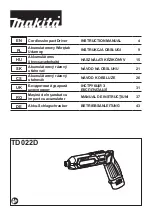
6. Con
fi
rm the tightening torque
The following factors contribute to a reduction of the
tightening torque. So con
fi
rm the actual tightening
torque needed by screwing up some bolts before the
job with a hand torque wrench. Factors a
ff
ecting the
tightening torque are as follows.
(1) Voltage
When the discharge margin is reached, voltage
decreases and tightening torque is lowered.
(2) Operating time
The tightening torque increases when the operating
time increases. But the tightening torque does not
increase above a certain value even if the tool is
driven for a long time.
(3) Diameter of bolt
The tightening torque di
ff
ers with the diameter of the
bolt. Generally a larger diameter bolt requires larger
tightening torque.
(4) Tightening conditions
The tightening torque di
ff
ers according to the torque
ratio; class, and length of bolts even when bolts with
the same size threads are used. The tightening torque
also di
ff
ers according to the condition of the surface of
workpiece through which the bolts are to be tightened.
When the bolt and nut turn together, torque is greatly
reduced.
(5) Tightening torque varies, depending on the battery’s
charge level.
MAINTENANCE AND INSPECTION
CAUTION: Pull out battery before doing any inspection or maintenance.
1
.
Checking the condition of the bit
The bits should be checked regularly. If worn or
broken bits can slip or decrease the e
ffi
ciency of the
motor and burn it out.
Replace worn bits with new ones.
CAUTION
If you use a driver bit of which point is worn or
broken, it will be dangerous since it slips. So
replace it with a new one.
2. Check the Screws
Loose screws are dangerous. Regularly inspect them
and make sure they are tight.
CAUTION
Using this power tool with loosened, screws is
extremely dangerous.
3. Maintenance of the motor
The motor unit winding is the very “heart” of the power
tool.
Exercise due care to ensure the winding does not
become damaged and/or wet with oil or water.
4. Check for Dust
Dust may be removed with a soft cloth or a cloth
dampened with soapy water.
Do not use bleach, chlorine, gasoline or thinner, for
they may damage the plastics.
5. Disposal of the exhausted battery
WARNING
Do not dispose of the exhausted battery. The
battery must explode if it is incinerated. The
product that you have purchased contains a
rechargeable battery. The battery is recyclable.
At the end of it’s useful life, under various state
and local laws, it may be illegal to dispose of this
battery into the municipal waste stream. Check
with your local solid waste o
ffi
cials for details in
your area for recycling options or proper disposal.
6. Storage
Storing in a place below 104°F (40°C) and out of the
reach of children.
NOTE
Storing
lithium
-
ion batteries
Make sure the lithium
-
ion batteries have been fully
charged before storing them.
Prolonged storage (3 months or more) of batteries with
a low charge may result in performance deterioration,
signi
fi
cantly reducing battery usage time or rendering
the batteries incapable of holding a charge.
However,
signi
fi
cantly reduced battery usage time
may be recovered by repeatedly charging and using
the batteries two to
fi
ve times.
If the battery usage time is extremely short despite
repeated charging and use, consider the batteries
dead and purchase new batteries.
7. Service and repairs
All quality power tools will eventually require servicing or
replacement of parts because of wear from normal use.
To assure that only authorized replacement parts will be
used, all service and repairs must be performed by a
HITACHI AUTHORIZED SERVICE CENTER, ONLY.
16
English
0000WH18DBFL2.indb 16
0000WH18DBFL2.indb 16
2017/08/22 12:10:31
2017/08/22 12:10:31
















































